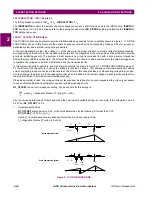
GE Power Management
ALPS Advanced Line Protection System
2-31
2 CALCULATION OF SETTINGS
2.3 PROTECTION SETTINGS
2
902: BYPASSTL3 - Bypass Line Pickup Time Delay
If simultaneous reclosing is used and if I1PICKUP (Setting 903) must be set below full load, then set BYPASSTL3 = NO,
otherwise set BYPASSTL3 = YES.
903: I1PICKUP - I1 Pickup Setting
I1 is the overcurrent trip unit used in the Line Pickup function, and it operates on the magnitude of the positive-sequence
current.
I1PICKUP should be set no greater than 2/3 of the minimum fault current for an internal three-phase fault at the relay loca-
tion. If the minimum fault current is greater than the maximum load current on the protected line, then the I1 setting can be
reduced to provide greater coverage of the line. For this case, a setting of 110% of the maximum load current is proposed.
2.3.12 REMOTEOPEN
The Remote-Open Detector (ROD) function issues a trip signal when the remote breaker opens during an unbalanced
internal fault. This function detects that the remote breaker has opened by recognizing charging current on one or more
phases following opening of the remote breaker. The Remote-Open Detector will not operate for a balanced three phase
fault.
ROD tripping can speed up tripping at the end of the line that otherwise would be the slowest to respond in a sequential-
tripping condition. In a Step Distance scheme, ROD tripping is beneficial for any unbalanced internal fault not detected by
Zone 1. In a Blocking scheme, ROD tripping is beneficial where system conditions are such that the fault current redistribu-
tion following breaker opening at one end is normally required before the other end(s) operates. The ROD function should
not be considered as a replacement or substitute for a pilot scheme. A functional logic diagram of the ROD function is
shown below. The sequence of events that results in an ROD output is as follows:
Figure 2–12: ROD LOGIC DIAGRAM
1.
No charging current is detected prior to the fault – logic 0 output from AND2.
2.
A fault is detected – logic 1 output from OR3.
3.
The remote breaker opens and charging current is detected – logic 1 output from AND3.
4.
The fault is still present, so the two inputs to AND4 persist and a trip output will be produced following the time-delay
setting of timer TL20.
If charging current is initially detected but the fault detector (FD) is not picked up, indicating no fault on the power system,
then OR1 and AND1 produce outputs. AND2 produces an output and seals itself in on the output of OR1 via OR2. AND3 is
now blocked from producing an output as long as charging current is detected, regardless of whether FD is picked up or
not. If a subsequent fault occurs and the remote breaker opens, ROD is prevented from producing an output.
A
0
I A L E A D S
V A B Y 9 0 °
I B L E A D S
V B B Y 9 0 °
I C L E A D S
V C B Y 9 0 °
F A U L T
D E T E C T O R
A N Y Z O N E 2
P H A S E - D I S T A N C E
F U N C T I O N
A N Y Z O N E 2
G R O U N D - D I S T A N C E
F U N C T I O N
1
1
2
2
4
3
3
A = 10 - 100
T L 2 0
T R I P










































